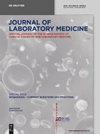第二代可溶性转铁蛋白受体测定——“托马斯图”解释的结果
IF 1.8
4区 医学
Q4 MEDICAL LABORATORY TECHNOLOGY
引用次数: 0
摘要
目的“托马斯图”是一种非常有用的诊断工具,用于评估、监测和治疗患者的铁状态和网织红细胞的血红蛋白。2021年,罗氏诊断推出了第二代可溶性转铁蛋白受体(sTfR)测定方法。在这里,我们比较了sTfR的旧方法和新方法,并分析了“托马斯图”的结果。方法采用Cobas8000系统测定sTfR、铁蛋白和CRP。使用Sysmex XN9000系统测定网织红细胞血红蛋白(Ret-He)含量。结果与第一代相比,第二代sTfR检测显示sTfR值始终较低,这将导致“托马斯图”的左移,并可能导致使用原始截止值对患者进行错误诊断。回顾性分析2016年至2021年“托马斯图”的一万五千五百九十二组数据集,以估计我院有多少患者会受到影响。结果,大约5%的“Thomas地块”将受到第二代检测的较低sTfR值的影响。结论由于第二代铁蛋白检测的sTfR值较低,为了正确诊断患者的铁状态,应使用新的铁蛋白指数(sTfR/lg铁蛋白)截止值。本文章由计算机程序翻译,如有差异,请以英文原文为准。
Second generation of soluble transferrin receptor assay – consequences for the interpretation of the ‘Thomas plot’
Abstract Objectives The ‘Thomas plot’ is a very helpful diagnostic tool for evaluation, monitoring and therapy of the iron status and on the hemoglobinization of the reticulocytes of patients. In 2021 Roche Diagnostics launched a second generation assay for determination of the soluble transferrin receptor (sTfR). Here we compare the old and the new assay for sTfR and analyze the consequences for the ‘Thomas plot’. Methods Measurement of sTfR, ferritin and CRP were done using a Cobas8000 system. Hemoglobin content of reticulocytes (Ret-He) was determined using a Sysmex XN9000 system. Results The second generation of sTfR assay showed consistently lower sTfR values compared to the first generation, which would result in a left shift of the ‘Thomas plot’ and may lead to false diagnosis of patients using the original cut-offs. Fifteen thousand five hundred ninty two data sets for ‘Thomas plot’ from 2016 to 2021 were retrospectively analyzed to estimate how many patients in our hospital would be affected. In result around 5 % of all ‘Thomas plots’ would be affected by the lower sTfR values of the second generation assays. Conclusions Due to the lower sTfR values measured with the second generation assay new cut-offs for the Ferritin-Index (sTfR/lg Ferritin) should be used in order to correctly diagnose the iron status of patients.
求助全文
通过发布文献求助,成功后即可免费获取论文全文。
去求助
来源期刊

Journal of Laboratory Medicine
Mathematics-Discrete Mathematics and Combinatorics
CiteScore
2.50
自引率
0.00%
发文量
39
审稿时长
10 weeks
期刊介绍:
The Journal of Laboratory Medicine (JLM) is a bi-monthly published journal that reports on the latest developments in laboratory medicine. Particular focus is placed on the diagnostic aspects of the clinical laboratory, although technical, regulatory, and educational topics are equally covered. The Journal specializes in the publication of high-standard, competent and timely review articles on clinical, methodological and pathogenic aspects of modern laboratory diagnostics. These reviews are critically reviewed by expert reviewers and JLM’s Associate Editors who are specialists in the various subdisciplines of laboratory medicine. In addition, JLM publishes original research articles, case reports, point/counterpoint articles and letters to the editor, all of which are peer reviewed by at least two experts in the field.
 求助内容:
求助内容: 应助结果提醒方式:
应助结果提醒方式:


